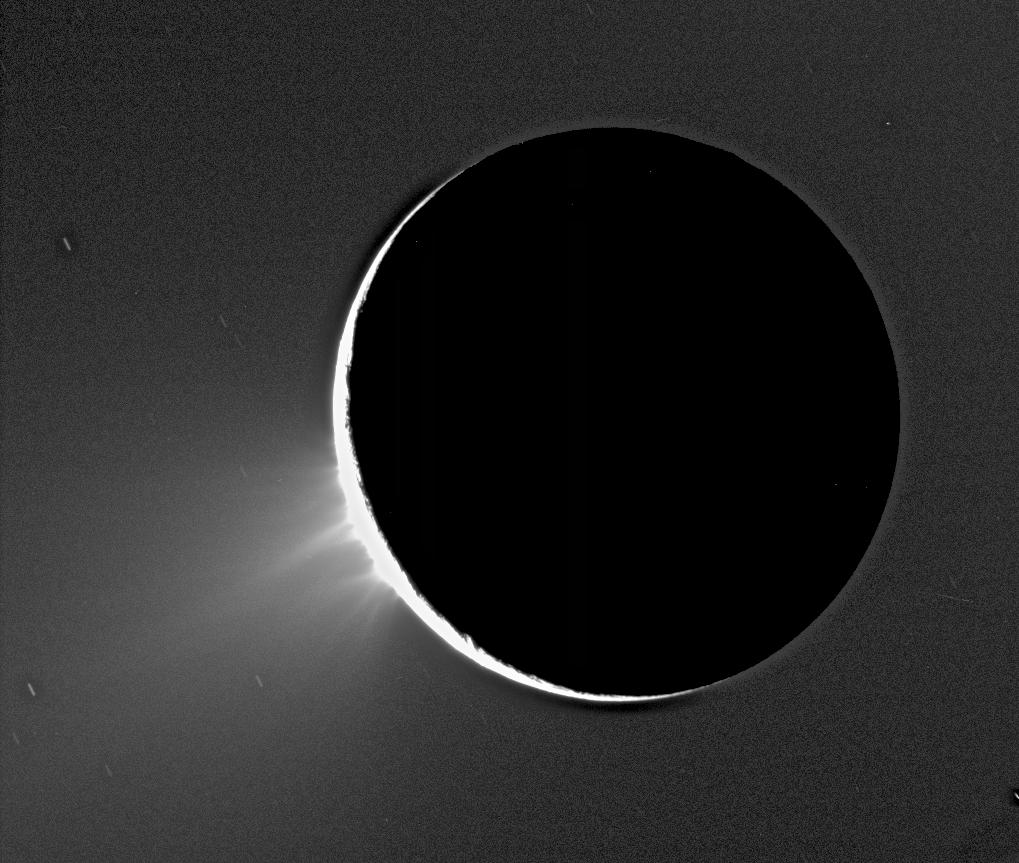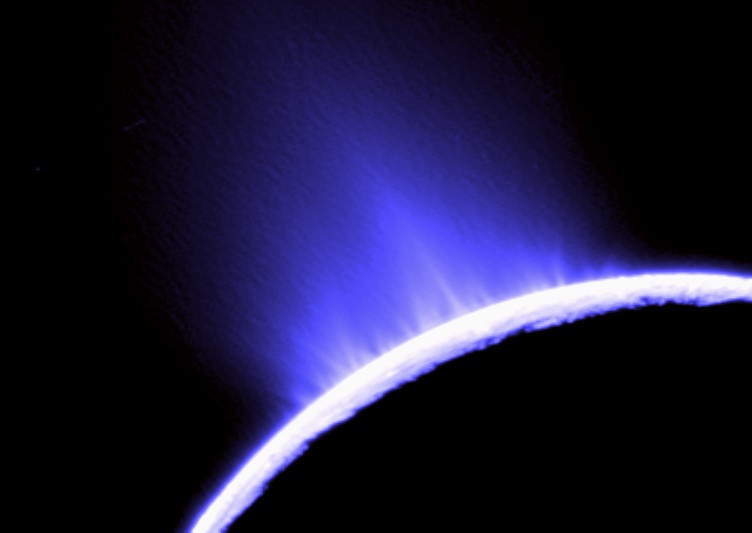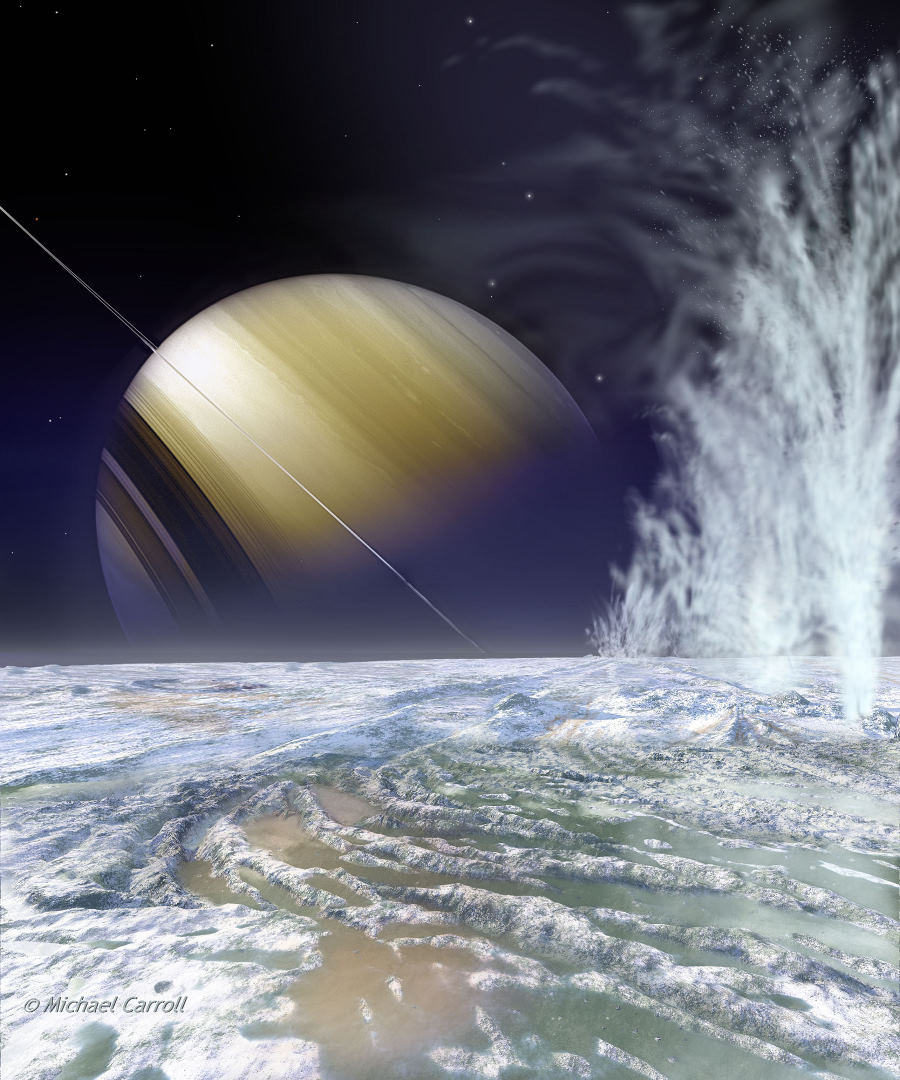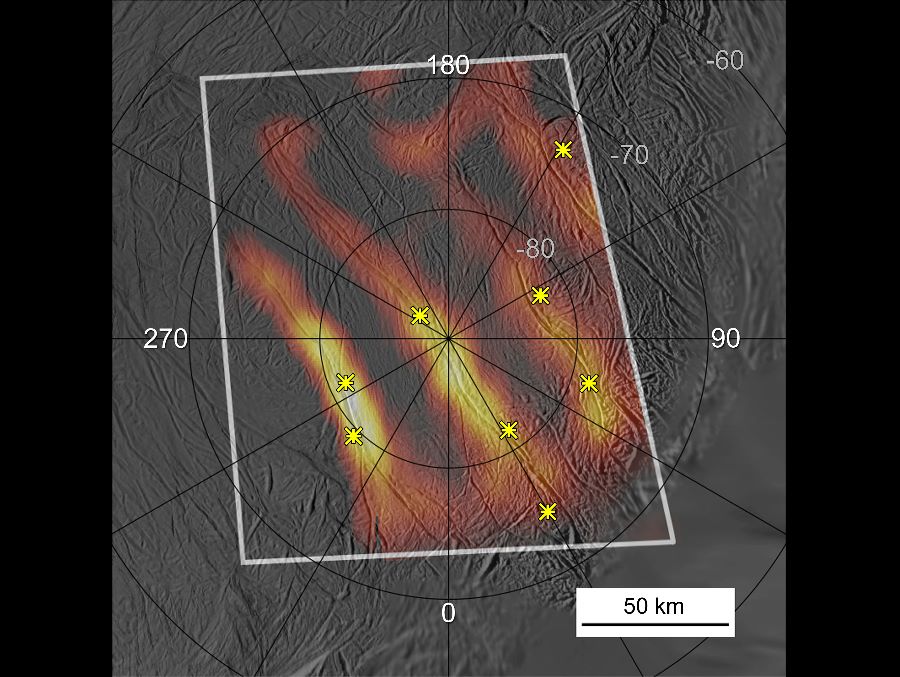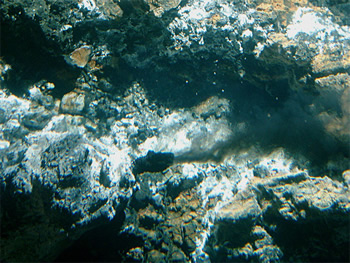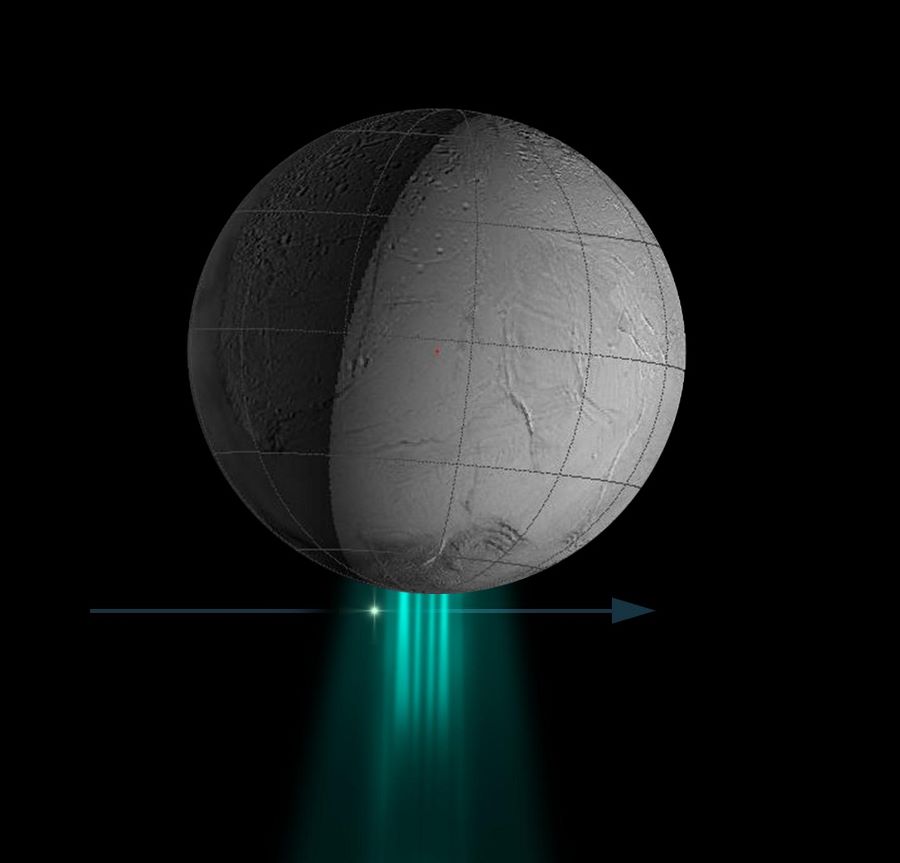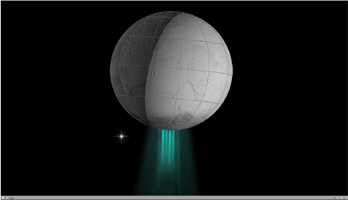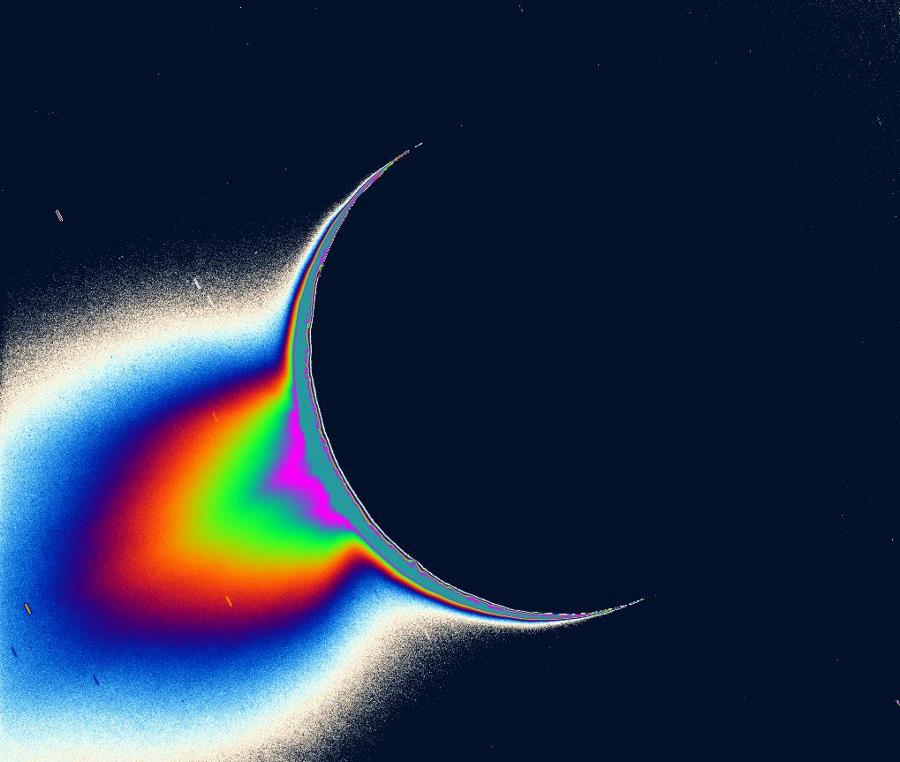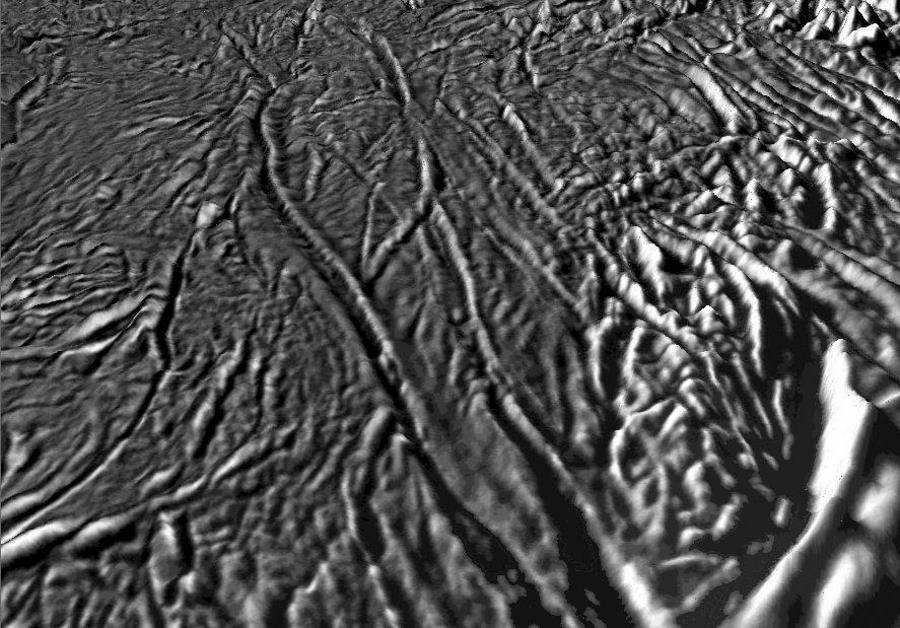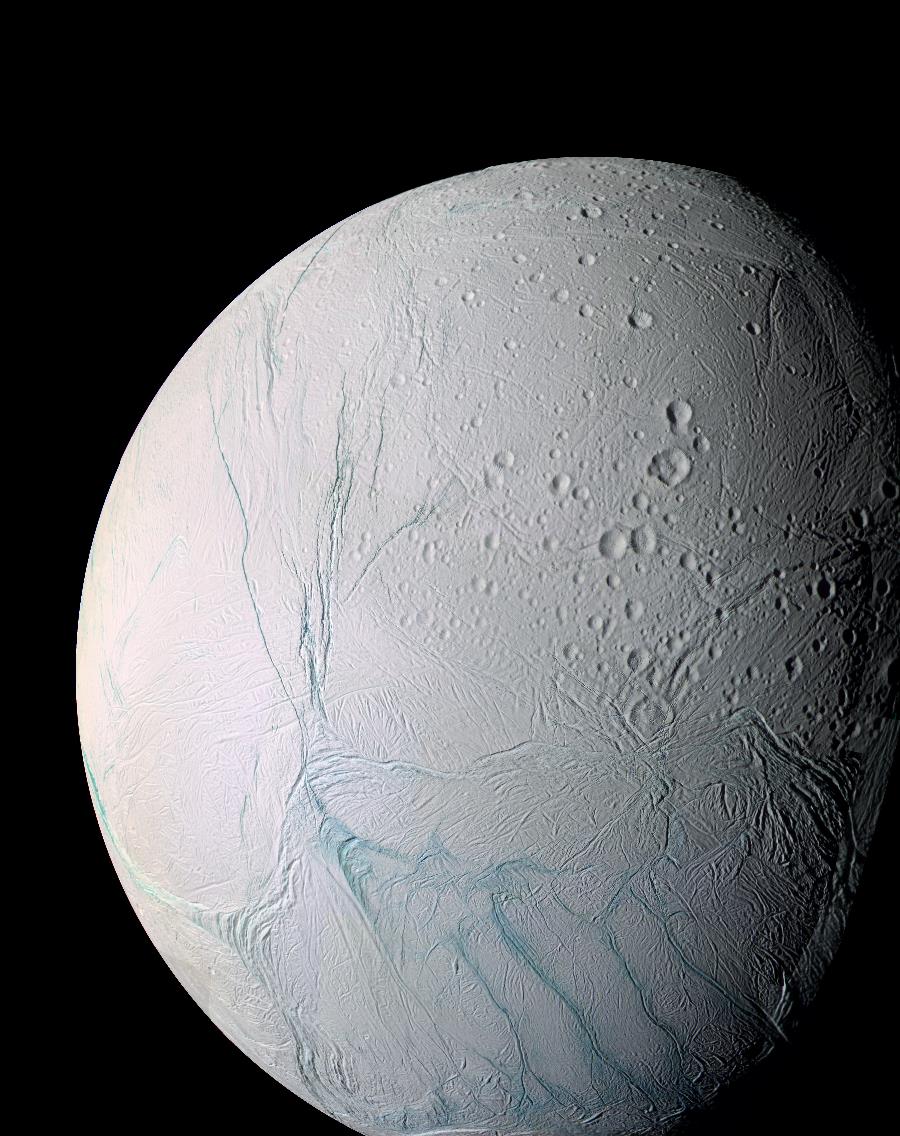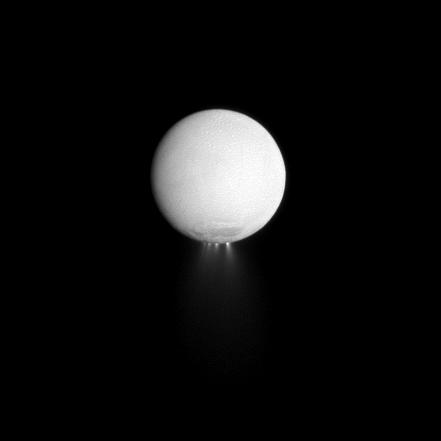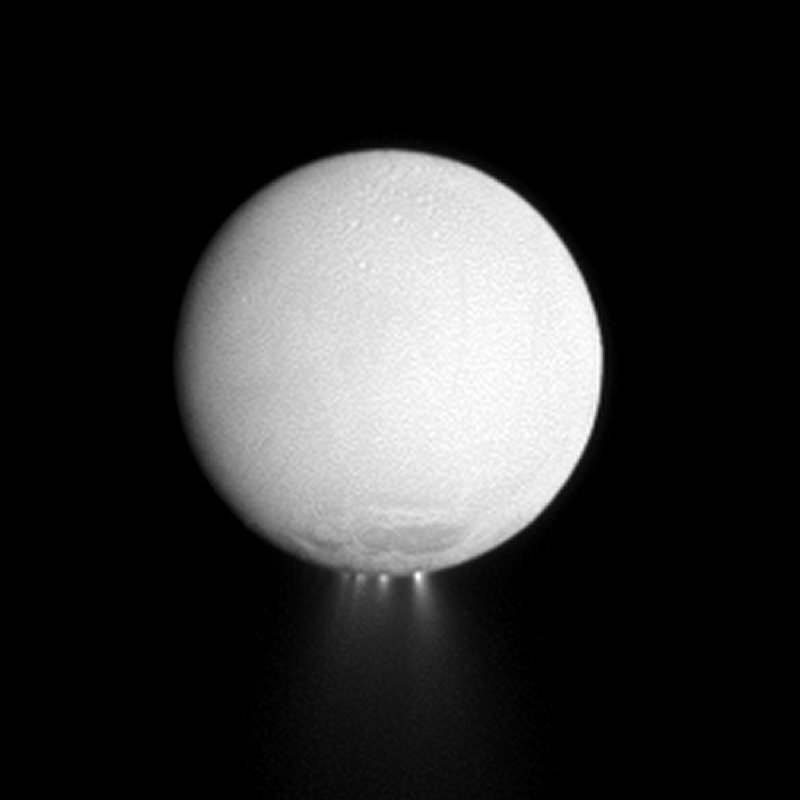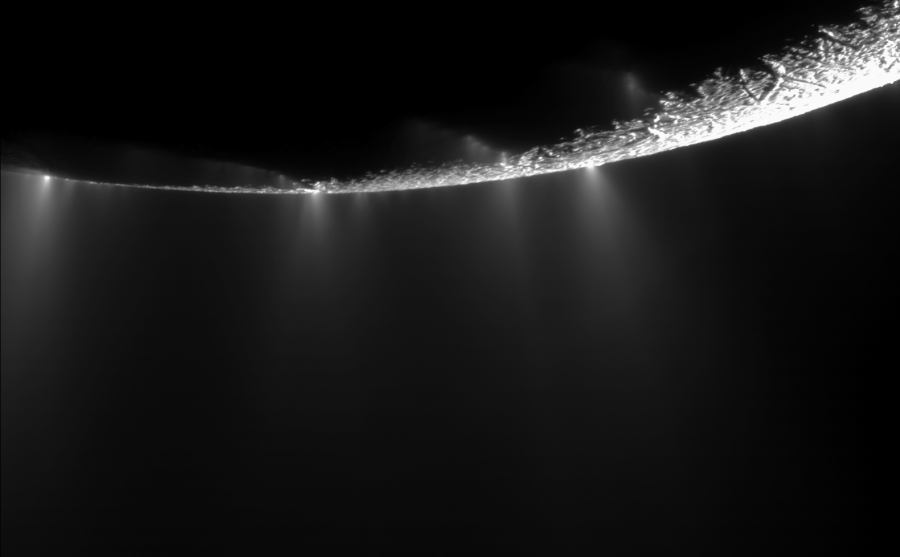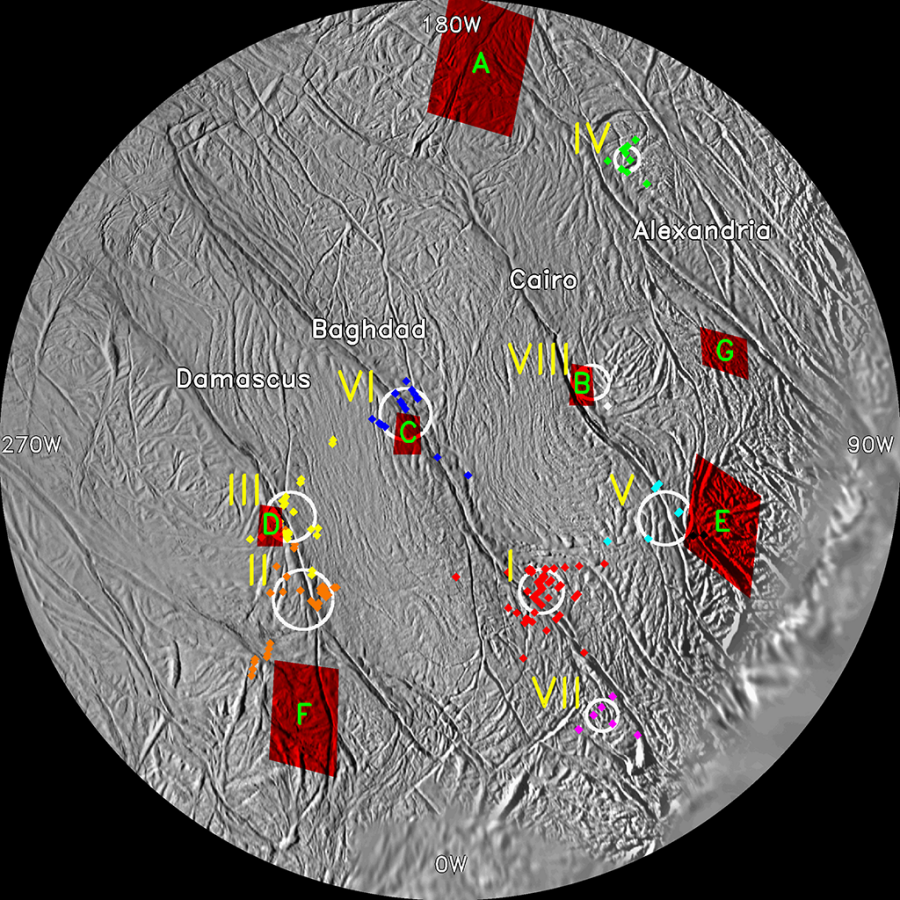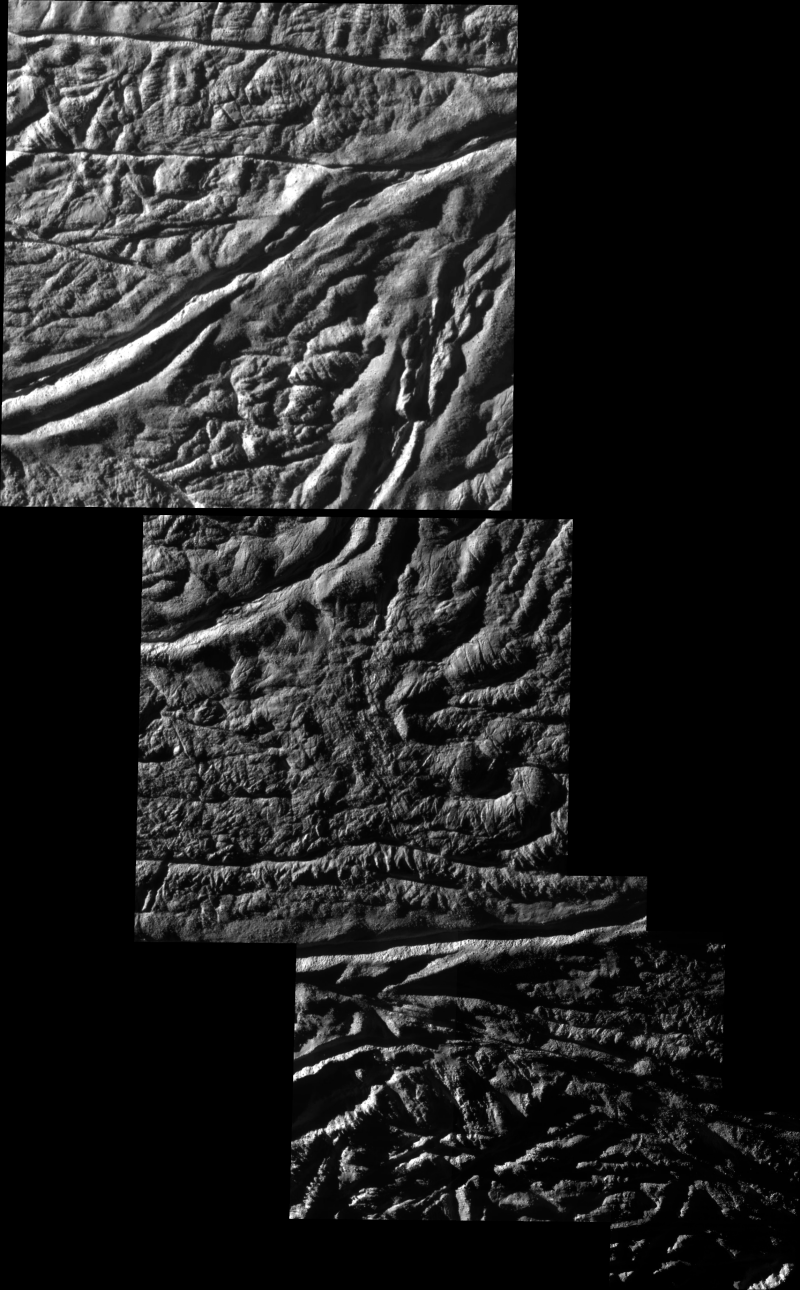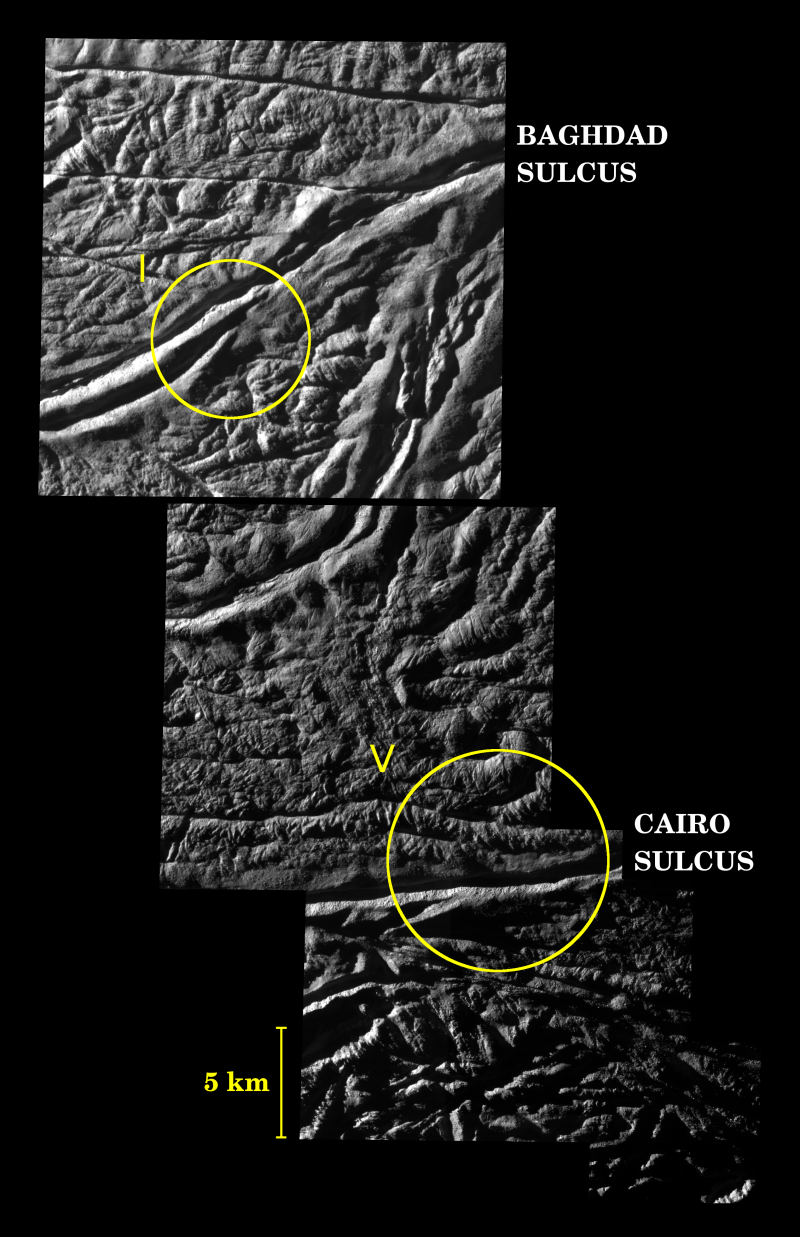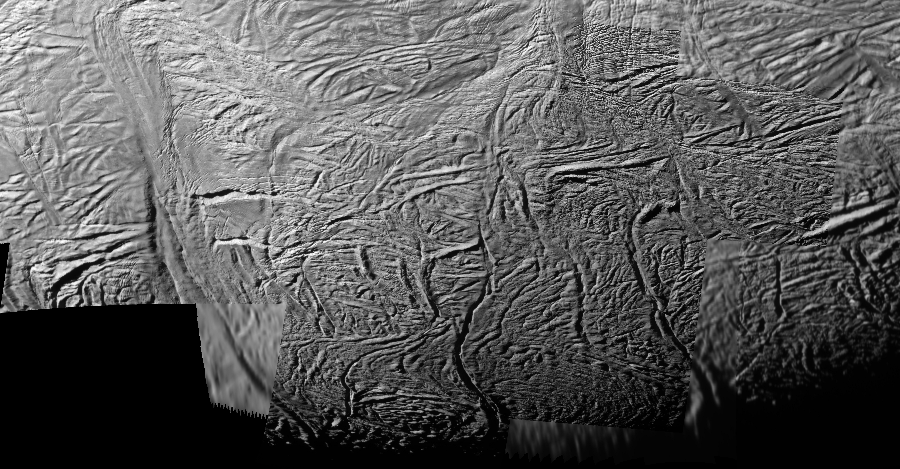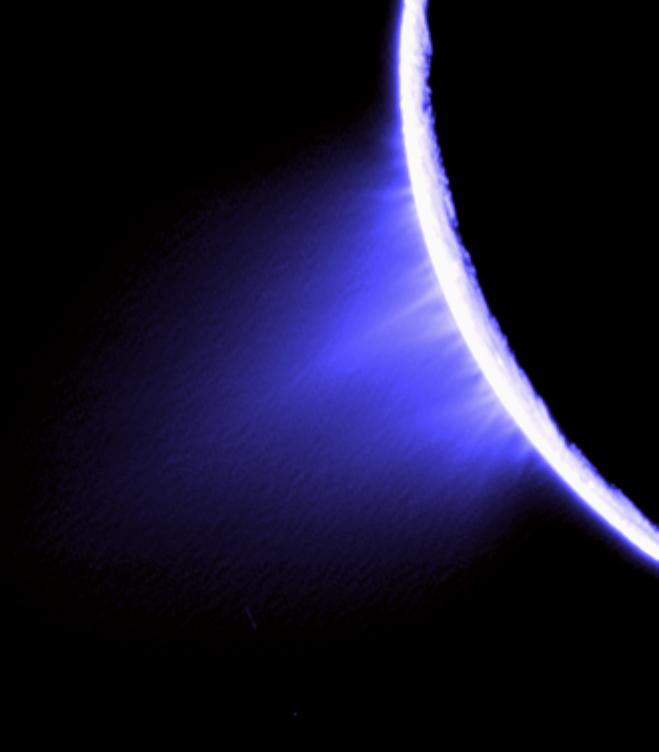|
The Enigmas on Enceladus |
||||
|
Moon of Saturn ..
Fountains of Enceladus Recent
Cassini images of Saturn's moon Enceladus
backlit by the sun show the fountain-like
sources of the fine spray of material that
towers over the south polar
region. This image was taken looking more or
less broadside at the "tiger
stripe" fractures observed in earlier Enceladus
images. It shows discrete
plumes of a variety of apparent sizes above the
limb of the moon. 27 November
2005. Credit: NASA/JPL/Space Science Institute
PIA07758: Fountains of Enceladus Caption: Recent Cassini images of Saturn's moon Enceladus backlit by the sun show the fountain-like sources of the fine spray of material that towers over the south polar region. This image was taken looking more or less broadside at the "tiger stripe" fractures observed in earlier Enceladus images. It shows discrete plumes of a variety of apparent sizes above the limb (edge) of the moon. This image was acquired on Nov. 27, 2005. Imaging scientists, as reported
in the journal Science on March 10, 2006, believe
that the jets are geysers
erupting from pressurized subsurface reservoirs of
liquid water above 273
degrees Kelvin (0 degrees Celsius). This caption was updated on March
9, 2006. The Cassini-Huygens mission is a cooperative project of NASA, the European Space Agency and the Italian Space Agency. The Jet Propulsion Laboratory, a division of the California Institute of Technology in Pasadena, manages the mission for NASA's Science Mission Directorate, Washington, D.C. The Cassini orbiter and its two onboard cameras were designed, developed and assembled at JPL. The imaging operations center is based at the Space Science Institute in Boulder, Colo. For more information about the Cassini-Huygens mission visit http://saturn.jpl.nasa.gov The Cassini imaging team homepage is at http://ciclops.org
Image Credit:
Image Addition
Date:
Image Source: NASA Photo Journal |
||||
|
October 13, 2007 ..
Explanation: Ice geysers erupt on Enceladus, bright and shiny inner moon of Saturn. Shown in this false-color image, a backlit view of the moon's southern limb, the majestic, icy plumes were discovered by instruments on the Cassini Spacecraft during close encounters with Enceladus in November of 2005. Eight source locations for these geysers have now been identified along substantial surface fractures in the moon's south polar region. Researchers suspect the geysers arise from near-surface pockets of liquid water with temperatures near 273 kelvins (0 degrees C). That's hot when compared to the distant moon's surface temperature of 73 kelvins (-200 degrees C). The cryovolcanism is a dramatic sign that tiny, 500km-diameter Enceladus is surprisingly active. Enceladus ice geysers also likely produce Saturn's faint but extended E ring. SOURCE: NASA APOD |
||||
|
Hints at Ocean Within Saturn Moon June 24, 2009 PASADENA, Calif. -- For the first time, scientists working on NASA's Cassini mission have detected sodium salts in ice grains of Saturn's outermost ring. Detecting salty ice indicates that Saturn's moon Enceladus, which primarily replenishes the ring with material from discharging jets, could harbor a reservoir of liquid water -- perhaps an ocean -- beneath its surface. Cassini discovered the water-ice jets in 2005 on Enceladus. These jets expel tiny ice grains and vapor, some of which escape the moon's gravity and form Saturn's outermost ring. Cassini's cosmic dust analyzer has examined the composition of those grains and found salt within them. "We believe that the salty minerals deep inside Enceladus washed out from rock at the bottom of a liquid layer," said Frank Postberg, Cassini scientist for the cosmic dust analyzer at the Max Planck Institute for Nuclear Physics in Heidelberg, Germany. Postberg is lead author of a study that appears in the June 25 issue of the journal Nature. Scientists on Cassini's cosmic dust detector team conclude that liquid water must be present because it is the only way to dissolve the significant amounts of minerals that would account for the levels of salt detected. The process of sublimation, the mechanism by which vapor is released directly from solid ice in the crust, cannot account for the presence of salt. "Potential plume sources on Enceladus are an active area of research with evidence continuing to converge on a possible salt water ocean," said Linda Spilker, Cassini deputy project scientist at NASA's Jet Propulsion Laboratory in Pasadena, Calif. "Our next opportunity to gather data on Enceladus will come during two flybys in November." The makeup of the outermost ring grains, determined when thousands of high-speed particle hits were registered by Cassini, provides indirect information about the composition of the plume material and what is inside Enceladus. The outermost ring particles are almost pure water ice, but nearly every time the dust analyzer has checked for the composition, it has found at least some sodium within the particles. "Our measurements imply that besides table salt, the grains also contain carbonates like soda. Both components are in concentrations that match the predicted composition of an Enceladus ocean," Postberg said. "The carbonates also provide a slightly alkaline pH value. If the liquid source is an ocean, it could provide a suitable environment on Enceladus for the formation of life precursors when coupled with the heat measured near the moon's south pole and the organic compounds found within the plumes." However, in another study published in Nature, researchers doing ground-based observations did not see sodium, an important salt component. That team notes that the amount of sodium being expelled from Enceladus is actually less than observed around many other planetary bodies. These scientists were looking for sodium in the plume vapor and could not see it in the expelled ice grains. They argue that if the plume vapor does come from ocean water, the evaporation must happen slowly deep underground, rather than as a violent geyser erupting into space. "Finding salt in the plume gives evidence for liquid water below the surface," said Sascha Kempf, also a Cassini scientist for the cosmic dust analyzer from the Max Planck Institute for Nuclear Physics. "The lack of detection of sodium vapor in the plume gives hints about what the water reservoir might look like." Determining the nature and origin of the plume material is a top priority for Cassini during its extended tour, called the Cassini Equinox Mission. "The original picture of the plumes as violently erupting Yellowstone-like geysers is changing," said Postberg."They seem more like steady jets of vapor and ice fed by a large water reservoir. However, we cannot decide yet if the water is currently 'trapped' within huge pockets in Enceladus' thick ice crust or still connected to a large ocean in contact with the rocky core." The Cassini-Huygens mission is a cooperative project of NASA, the European Space Agency and the Italian Space Agency. The Cassini cosmic dust analyzer was provided by the German Aerospace Center. The Cassini orbiter was designed, developed and assembled at JPL. JPL manages the mission for the Science Mission Directorate at NASA Headquarters in Washington. More information about the Cassini mission is available at http://www.nasa.gov/cassini or http://saturn.jpl.nasa.gov . Media Contacts:
Dwayne Brown 202-358-1726
2009-101 SOURCE: NASA PRESS RELEASE June 24, 2009 |
||||
Related Links:
|
||||
|
June 08, 2006 ..
Explanation: Explanation: In this stunning Saturnian vista - one in a series of artist's visions of volcanos on alien worlds - icy geysers erupt along narrow fractures in inner moon Enceladus. The majestic plumes were actually discovered by instruments on the Cassini Spacecraft during close encounters with bright and shiny Enceladus last year. Researchers now suspect the plumes originate from near-surface pockets of liquid water with temperatures near 273 kelvins (0 degrees C) - hot when compared to the distant moon's surface temperature of 73 kelvins (-200 degrees C). A dramatic sign that tiny, 500km-diameter Enceladus is surprisingly active, these ice volcanos hold out another potential site in the search for water and origin of life beyond planet Earth. Enceladus' ice volcanos also likely produce Saturn's faint but extended E ring. SOURCE: NASA APOD |
||||
|
..
Heat radiating from the entire length of 150 kilometer (95 mile)-long fractures is seen in this best-yet heat map of the active south polar region of Saturn's ice moon Enceladus. The warmest parts of the fractures tend to lie on locations of the plume jets identified in earlier images, shown in the annotated version with yellow stars. The measurements were obtained by the Cassini spacecraft's Composite Infrared Spectrometer from the spacecraft's close flyby of the moon on March 12, 2008. Remarkably high temperatures, at least 180 Kelvin (minus 135 degrees Fahrenheit) were registered along the brightest fracture, named Damascus Sulcus, in the lower left portion of the image. For comparison, surface temperatures elsewhere in the south polar region of Enceladus are below 72 Kelvin (minus 330 degrees Fahrenheit). Heat is escaping from Enceladus' interior along these warm fractures, dubbed "tiger stripes," which are also the source of the geysers that erupt from the polar region. The infrared radiation was mapped at wavelengths between 12 and 16 microns. The infrared data, shown in false color, are superimposed on a grayscale image mosaic of the south pole obtained by Cassini's cameras on July 14, 2005, during the previous close Enceladus flyby. Numbers on the map indicate latitude and longitude. This new view shows that at least three of the south polar fractures are active along almost their full lengths--the fourth one, on the right, was only partially covered by this scan. The level of activity varies greatly along the fractures. The warmest parts of the fractures tend to lie on locations of the plume jets identified in earlier images. The main "tiger stripe" fractures are not the only sources of heat, however; additional warm spots are seen in the upper right part of the scan. The warm regions are probably concentrated within less than a few hundred meters (a few hundred yards) of the fractures, and their apparent width in this image results from the relatively low resolution of the infrared data. This map was made by scanning the south pole during the period from 16 to 37 minutes after closest approach to Enceladus, at a distance between 14,000 and 32,000 kilometers (about 8,700 and 20,000 miles) as Cassini rapidly receded from its close (50-kilometer or 32-mile) flyby. The Cassini-Huygens mission is a cooperative project of NASA, the European Space Agency and the Italian Space Agency. The Jet Propulsion Laboratory, a division of the California Institute of Technology in Pasadena, manages the mission for NASA's Science Mission Directorate, Washington, D.C. The Cassini orbiter was designed, developed and assembled at JPL. The composite infrared spectrometer team is based at NASA's Goddard Space Flight Center, Greenbelt, Md. For more information about the Cassini-Huygens mission visit http://ciclops.org March 26, 2008 PASADENA, Calif. -- NASA's Cassini spacecraft tasted and sampled a surprising organic brew erupting in geyser-like fashion from Saturn's moon Enceladus during a close flyby on March 12. Scientists are amazed that this tiny moon is so active, "hot" and brimming with water vapor and organic chemicals. New heat maps of the surface show higher temperatures than previously known in the south polar region, with hot tracks running the length of giant fissures. Additionally, scientists say the organics "taste and smell" like some of those found in a comet. The jets themselves harmlessly peppered Cassini, exerting measurable torque on the spacecraft, and providing an indirect measure of the plume density. "A completely unexpected surprise is that the chemistry of Enceladus, what's coming out from inside, resembles that of a comet," said Hunter Waite, principal investigator for the Cassini Ion and Neutral Mass Spectrometer at the Southwest Research Institute in San Antonio. "To have primordial material coming out from inside a Saturn moon raises many questions on the formation of the Saturn system." "Enceladus is by no means a comet. Comets have tails and orbit the sun, and Enceladus' activity is powered by internal heat while comet activity is powered by sunlight. Enceladus' brew is like carbonated water with an essence of natural gas," said Waite. The Ion and Neutral Mass Spectrometer saw a much higher density of volatile gases, water vapor, carbon dioxide and carbon monoxide, as well as organic materials, some 20 times denser than expected. This dramatic increase in density was evident as the spacecraft flew over the area of the plumes. New high-resolution heat maps of the south pole by Cassini's Composite Infrared Spectrometer show that the so-called tiger stripes, giant fissures that are the source of the geysers, are warm along almost their entire lengths, and reveal other warm fissures nearby. These more precise new measurements reveal temperatures of at least minus 93 degrees Celsius (minus 135 Fahrenheit.) That is 35 degrees Celsius (63 degrees Fahrenheit) warmer than previously seen and 115 degrees Celsius (207 degrees Fahrenheit) warmer than other regions of the moon. The warmest regions along the tiger stripes correspond to two of the jet locations seen in Cassini images. "These spectacular new data will really help us understand what powers the geysers. The surprisingly high temperatures make it more likely that there's liquid water not far below the surface," said John Spencer, Cassini scientist on the Composite Infrared Spectrometer team at the Southwest Research Institute in Boulder, Colo. Previous ultraviolet observations showed four jet sources, matching the locations of the plumes seen in previous images. This indicates that gas in the plume blasts off the surface into space, blending to form the larger plume. Images from previous observations show individual jets and mark places from which they emanate. New images show how hot spot fractures are related to other surface features. In future imaging observations, scientists hope to see individual plume sources and investigate differences among fractures. "Enceladus has got warmth, water and organic chemicals, some of the essential building blocks needed for life," said Dennis Matson, Cassini project scientist at NASA's Jet Propulsion Laboratory in Pasadena, Calif. "We have quite a recipe for life on our hands, but we have yet to find the final ingredient, liquid water, but Enceladus is only whetting our appetites for more." At closest approach, Cassini was only 30 miles from Enceladus. When it flew through the plumes it was 120 miles from the moon's surface. Cassini's next flyby of Enceladus is in August. The Cassini-Huygens mission is a cooperative project of NASA, the European Space Agency and the Italian Space Agency. The mission is managed by JPL for NASA's Science Mission Directorate, Washington. For images and more information, visit http://www.nasa.gov/cassini or http://saturn.jpl.nasa.gov/. Media contacts: Carolina Martinez
Dwayne Brown 202-358-2726
2008-050 SOURCE: NASA Press Release March 26, 2008
Life flourishes even in this hostile environment. Image credit: A.L. Lane, NASA/JPL ..
PIA10354: Stellar Data on Plume New structure, density and composition measurements of Enceladus' water plume were obtained when the Cassini spacecraft's Ultraviolet Imaging Spectrograph observed the star zeta Orionis pass behind the plume Oct. 24, 2007, as seen in this animation. Changes in the starlight as it dimmed while passing through the plume allowed the spectrograph to identify the plume's physical and chemical composition. The spectrograph detected four high-density gas streams composed of water vapor. The density of the water vapor is twice that of the broad plume of gas that surrounds each jet. This measurement confirms the theoretical analysis performed prior to the flyby that showed it was safe for Cassini to fly very closely past Enceladus, even through part of the plume, during the March 12, 2008 flyby. At closest approach, Cassini was only 30 miles from Enceladus. When it flew through the plumes it was 120 miles from the moon's surface. Cassini's next flyby of Enceladus is in August. The Cassini-Huygens mission is a
cooperative project
of NASA, the European Space Agency and the Italian
Space Agency. The mission
is managed by JPL for NASA's Science Mission
Directorate, Washington.
Stellar Data on Plume NASA/JPL/University of Colorado/SSI Image Addition Date:
SOURCE: NASA Photo Journal PIA10354 |
||||
|
..
PIA07759: Fountains of Enceladus - Image #2 Caption: Recent Cassini images of Saturn's moon Enceladus backlit by the sun show the fountain-like sources of the fine spray of material that towers over the south polar region. The image was taken looking more or less broadside at the "tiger stripe" fractures observed in earlier Enceladus images. It shows discrete plumes of a variety of apparent sizes above the limb of the moon. The greatly enhanced and colorized image shows the enormous extent of the fainter, larger-scale component of the plume. Imaging scientists, as reported in the journal Science on March 10, 2006, believe that the jets are geysers erupting from pressurized subsurface reservoirs of liquid water above 273 degrees Kelvin (0 degrees Celsius). This caption was updated on March 9, 2006. The Cassini-Huygens mission is a cooperative project of NASA, the European Space Agency and the Italian Space Agency. The Jet Propulsion Laboratory, a division of the California Institute of Technology in Pasadena, manages the mission for NASA's Science Mission Directorate, Washington, D.C. The Cassini orbiter and its two onboard cameras were designed, developed and assembled at JPL. The imaging operations center is based at the Space Science Institute in Boulder, Colo. For more information about the Cassini-Huygens mission visit http://saturn.jpl.nasa.gov The Cassini imaging team homepage is at http://ciclops.org Image Credit:
Image Addition
Date:
Image Source: NASA Photo Journal PIA07759 |
||||
| Enceladus'
South Polar Stripes
Spew "Warm" Water
By Emily Lakdawalla July 30, 2005 Most of the solid-surfaced worlds in the Solar System are dormant or dead; the last chapters in their geologic histories were written long ago, and now they are only collecting craters. Until this week, only Earth and Jupiter's moon Io had ever been directly observed in the throes of geologic activity reshaping their surfaces. Now, Saturn's moon Enceladus has joined this select group. The great fissures seaming Enceladus' south pole are hot vents that actively spew water vapor into Enceladus' atmosphere. The discovery was made by nearly all of the Cassini orbiter's instruments acting in concert. Prior to Cassini's arrival, Enceladus had already been marked for particularly close attention during Cassini's orbital tour, thanks to the Voyager discovery that Enceladus had a geologically youthful surface, likely less than 100 million years in age. Also, Enceladus is theorized to be the origin of the particles that compose Saturn's most tenuous E ring. Enceladus was scheduled for three close flybys of less than 1000 kilometers (600 miles) altitude, more close encounters than for any other Saturn moon except Titan. SOURCE: The Planetary Society |
||||
|
Moon of Saturn March 31, 2008 ..
Credit: Paul Shenk (LPI), USRA; Cassini Imaging Team, SSI, JPL, ESA, NASA Explanation: Could life exist beneath Enceladus? A recent flyby of Saturn's icy moon has bolstered this fascinating idea. Two years ago, images from the robotic Cassini spacecraft orbiting Saturn led astronomers to the undeniable conclusion that Saturn's moon Enceladus was spewing fountains of gas and ice crystals through cracks in its surface dubbed tiger stripes. Last month, Cassini dove through some of these plumes and determined that they contained water vapor laced with small amounts of methane as well as simple and complex organic molecules. Surprisingly, the plumes of Enceladus appear similar in make-up to many comets. What's more, the temperature and density of the plumes indicate they might have originated from a warmer source -- possibly a liquid source -- beneath the surface. A liquid water sea containing organic molecules is a good place to look for life. Pictured above is a vertically exaggerated close-up of some long, venting tiger stripes. The computer composite was generated from images and shadows taken during the recent Cassini flyby. Nine more flybys of Enceladus by Cassini are planned. SOURCE: NASA APOD |
||||
|
..
PIA07800: Enceladus the Storyteller Caption: A masterpiece of deep time and wrenching gravity, the tortured surface of Saturn's moon Enceladus and its fascinating ongoing geologic activity tell the story of the ancient and present struggles of one tiny world. This is a story that is recounted by imaging scientists in a paper published in the journal Science on March 10, 2006. The enhanced color view of Enceladus seen here is largely of the southern hemisphere and includes the south polar terrain at the bottom of the image. Ancient craters remain somewhat pristine in some locales, but have clearly relaxed in others. Northward-trending fractures, likely caused by a change in the moon's rate of rotation and the consequent flattening of the moon's shape, rip across the southern hemisphere. The south polar terrain is marked by a striking set of `blue' fractures and encircled by a conspicuous and continuous chain of folds and ridges, testament to the forces within Enceladus that have yet to be silenced. The mosaic was created from 21 false-color frames taken during the Cassini spacecraft's close approaches to Enceladus on March 9 and July 14, 2005. Images taken using filters sensitive to ultraviolet, visible and infrared light (spanning wavelengths from 338 to 930 nanometers) were combined to create the individual frames. The mosaic is an orthographic projection centered at 46.8 degrees south latitude, 188 degrees west longitude, and has an image scale of 67 meters (220 feet) per pixel. The original images ranged in resolution from 67 meters per pixel to 350 meters (1,150 feet) per pixel and were taken at distances ranging from 11,100 to 61,300 kilometers (6,900 to miles) from Enceladus. The Cassini-Huygens mission is a cooperative project of NASA, the European Space Agency and the Italian Space Agency. The Jet Propulsion Laboratory, a division of the California Institute of Technology in Pasadena, manages the mission for NASA's Science Mission Directorate, Washington, D.C. The Cassini orbiter and its two onboard cameras were designed, developed and assembled at JPL. The imaging operations center is based at the Space Science Institute in Boulder, Colo. For more information about the Cassini-Huygens mission visit http://saturn.jpl.nasa.gov The Cassini imaging team homepage is at http://ciclops.org Image Credit:
Image Addition
Date:
Image Source: NASA Photo Journal PIA07800 |
||||
|
PIA12733: Highlighting Plumes ..
PIA12733: Highlighting Plumes At least four distinct plumes of water ice spew out from the south polar region of Saturn's moon Enceladus in this dramatically illuminated image. Light reflected off Saturn is illuminating the surface of the moon while the sun, almost directly behind Enceladus, is backlighting the plumes. See PIA11688 to learn more about Enceladus and its plumes. This view looks toward the Saturn-facing side of Enceladus (504 kilometers, or 313 miles across). North is up. The image was taken in visible light with the Cassini spacecraft narrow-angle camera on Dec. 25, 2009. The view was obtained at a distance of approximately 617,000 kilometers (383,000 miles) from Enceladus and at a Sun-Enceladus-spacecraft, or phase, angle of 174 degrees. Image scale is 4 kilometers (2 miles) per pixel. The Cassini-Huygens mission is a cooperative project of NASA, the European Space Agency and the Italian Space Agency. The Jet Propulsion Laboratory, a division of the California Institute of Technology in Pasadena, manages the mission for NASA's Science Mission Directorate, Washington, D.C. The Cassini orbiter and its two onboard cameras were designed, developed and assembled at JPL. The imaging operations center is based at the Space Science Institute in Boulder, Colo. For more information about the Cassini-Huygens mission visit http://saturn.jpl.nasa.gov The Cassini imaging team homepage is at http://ciclops.org Image Credit:
NASA/JPL/Space
Science Institute
|
||||
|
PIA11688: Bursting at the Seams ..
PIA11688: Bursting at the Seams Dramatic plumes, both large and small, spray water ice out from many locations along the famed "tiger stripes" near the south pole of Saturn's moon Enceladus. The tiger stripes are fissures that spray icy particles, water vapor and organic compounds. More than 30 individual jets of different sizes can be seen in this image and more than 20 of them had not been identified before. At least one jet spouting prominently in previous images now appears less powerful. This mosaic was created from two high-resolution images that were captured by the narrow-angle camera when NASA's Cassini spacecraft flew past Enceladus and through the jets on Nov. 21, 2009. (For other images captured during the same flyby, see PIA11686 and PIA11687). Imaging the jets over time will allow Cassini scientists to study the consistency of their activity. The south pole of the moon lies near the limb in the top left quadrant of the mosaic, near the large jet that is second from left. Lit terrain seen here is on the leading hemisphere of Enceladus (504 kilometers, 313 miles across). Cassini scientists continue to study the question of whether reservoirs of liquid water exist beneath the surface of the moon. See PIA11114 and PIA08386 to learn more. The view was obtained at a distance of approximately 14,000 kilometers (9,000 miles) from Enceladus and at a sun-Enceladus-spacecraft, or phase, angle of 145 degrees. Image scale is 81 meters (267 feet) per pixel. The Cassini-Huygens mission is a cooperative project of NASA, the European Space Agency and the Italian Space Agency. The Jet Propulsion Laboratory, a division of the California Institute of Technology in Pasadena, manages the mission for NASA's Science Mission Directorate in Washington. The Cassini orbiter and its two onboard cameras were designed, developed and assembled at JPL. The imaging team is based at the Space Science Institute, Boulder, Colo. For more information about the Cassini-Huygens mission visit http://saturn.jpl.nasa.gov The Cassini imaging team homepage is at http://ciclops.org Image Credit:
NASA/JPL/Space
Science Institute
|
||||
|
PIA08385: Enceladus Jet Sources ..
PIA08385: Enceladus Jet Sources This map of the south polar region of Saturn's moon Enceladus shows the correlation between jet sources identified in Cassini imaging data and hot spots on the surface located by the composite infrared spectrometer instrument. To identify jet source locations on the surface, imaging scientists carefully measured the locations and orientations of individual jets observed along the moon's limb in Cassini images taken from multiple viewing angles (see PIA08386). For each jet measurement, the researchers then computed a curve, or ground track, on the surface of Enceladus along which that jet might lie. The ground tracks from all of the measurements made in the various images produced many intersections on this map. By considering the jet directions at every possible intersection, the researchers isolated eight clusters of ground track intersections as jet sources. The eight identified jet source locations are labeled with yellow roman numerals. Composite infrared spectrometer hot spots are red boxes labeled with green capital letters. The line-of-sight intersections indicating the measurements of each source in individual images are shown as colored diamonds. White circles indicate the uncertainty in the locations of those sets of intersections. The map is a polar stereographic projection of Cassini imaging data. The four tiger stripe fractures, or sulci, are labeled here. The south pole is dead center on the map. Key longitudes are also labeled around the perimeter of the map. The Cassini-Huygens mission is a cooperative project of NASA, the European Space Agency and the Italian Space Agency. The Jet Propulsion Laboratory, a division of the California Institute of Technology in Pasadena, manages the mission for NASA's Science Mission Directorate, Washington, D.C. The Cassini orbiter and its two onboard cameras were designed, developed and assembled at JPL. The imaging operations center is based at the Space Science Institute in Boulder, Colo. For more information about the Cassini-Huygens mission visit http://saturn.jpl.nasa.gov The Cassini imaging team homepage is at http://ciclops.org Image Credit:
NASA/JPL/Space
Science Institute
|
||||
|
PIA11114: Baghdad and Cairo Sulci on Enceladus ..
PIA11114: Baghdad and Cairo Sulci on Enceladus Cassini shot past the surface of Saturn's moon Enceladus on Aug. 11, 2008, acquiring a set of seven high-resolution images targeting known jet source locations on the moon's "tiger stripe" fractures, or sulci. Five of those images are presented in this mosaic; the other two images are shown in PIA11113. Features on Enceladus are named for characters and places from "The Arabian Nights," and the four most prominent sulci are named Alexandria, Cairo, Baghdad and Damascus. Here, Baghdad Sulcus runs across the top mosaic tile, from lower left to upper right. Cairo Sulcus runs from left to right just beneath the center tile. One highly anticipated result of this flyby was to pinpoint previously identified source locations for the jets that blast icy particles, water vapor and trace organics into space (see PIA08385). The yellow circles on the annotated version of the mosaic indicate source locations I and V identified in PIA08385. Scientists are using these new images to study geologic activity associated with the sulci, and effects on the surrounding terrain. This information, coupled with observations by Cassini's other instruments, may answer the question of whether reservoirs of liquid water exist beneath the surface. The mosaic consists of five images taken with the clear spectral filters on Cassini's narrow-angle camera. The view is an orthographic projection with an image scale of 14.5 meters (47.5 feet) per pixel. The area shown here is centered on 81.6 degrees south latitude, 56.5 degrees west longitude. The original images ranged in resolution from 10 to 24 meters (33 to 79 feet) per pixel and were taken at distances ranging from 1,288 to 3,600 kilometers (800 to 2,237 miles) from Enceladus. The Cassini-Huygens mission is a cooperative project of NASA, the European Space Agency and the Italian Space Agency. The Jet Propulsion Laboratory, a division of the California Institute of Technology in Pasadena, manages the mission for NASA's Science Mission Directorate, Washington, D.C. The Cassini orbiter and its two onboard cameras were designed, developed and assembled at JPL. The imaging operations center is based at the Space Science Institute in Boulder, Colo. For more information about the Cassini-Huygens mission visit http://saturn.jpl.nasa.gov The Cassini imaging team homepage is at http://ciclops.org Image Credit:
NASA/JPL/Space
Science Institute
|
||||
|
PIA11686: Enceladan Tectonics ..
PIA11686: Enceladan Tectonics This mosaic shows extraordinary details of tectonic deformation in the fractured south polar region of Saturn's moon Enceladus, where jets of water ice spray outward to form Saturn's E ring. The images were captured by NASA's Cassini spacecraft. This image and others like it from the close flyby of Enceladus on Nov. 21, 2009, are among the best visible light images Cassini will capture of the region around the "tiger stripes," the fissures that spray icy particles, water vapor and organic compounds, before the moon's south polar region enters winter darkness for the coming years. Cassini scientists will use these new images to study geological activity associated with the tiger stripes and their effects on the surrounding terrain. See PIA11687 and PIA11688 to learn more. In this view, three prominent tiger stripe fractures extend from the bottom center of the mosaic upwards toward the center. From left to right, they are Alexandria Sulcus, Cairo Sulcus, and Baghdad Sulcus. Across the middle of the image, near the northern end of the tiger stripes, a conspicuous pattern of parallel 90-degree bends has formed. The bends curve along similar paths, that is, starting in a direction parallel to tiger stripes at one end and turning perpendicular at the other. Changes in the nature of regional tectonic stresses presumably cause the bends and narrow ridges to form perpendicular to tiger stripe direction. Analyzing systematic tectonic patterns like these throughout the south polar region may lead to an understanding of the forces and mechanism that drive Enceladus' activity. See PIA11114 and PIA08386 to learn more. This mosaic was created from six images that are also part of a larger mosaic (see PIA11685). The images were re-projected into orthographic map projection. This view looks toward south polar terrain of Enceladus (504 kilometers, 313 miles across). This view is centered on terrain at 73 degrees south latitude, 54 degrees west longitude. The images were obtained in visible light with the Cassini spacecraft narrow-angle camera on Nov. 21, 2009. The view was obtained at distances of approximately 3,200 kilometers (2,000 miles) to 7,000 kilometers (4,300 miles). Image scale is about 18 meters (58 feet) per pixel. The Cassini-Huygens mission is a cooperative project of NASA, the European Space Agency and the Italian Space Agency. The Jet Propulsion Laboratory, a division of the California Institute of Technology in Pasadena, manages the mission for NASA's Science Mission Directorate, Washington, D.C. The Cassini orbiter and its two onboard cameras were designed, developed and assembled at JPL. The imaging operations center is based at the Space Science Institute in Boulder, Colo. For more information about the Cassini-Huygens mission visit http://saturn.jpl.nasa.gov The Cassini imaging team homepage is at http://ciclops.org Image Credit:
NASA/JPL/Space
Science Institute
|
||||
|
PIA11686: Enceladan Tectonics ..
PIA11686: Enceladan Tectonics This mosaic shows extraordinary details of tectonic deformation in the fractured south polar region of Saturn's moon Enceladus, where jets of water ice spray outward to form Saturn's E ring. The images were captured by NASA's Cassini spacecraft. This image and others like it from the close flyby of Enceladus on Nov. 21, 2009, are among the best visible light images Cassini will capture of the region around the "tiger stripes," the fissures that spray icy particles, water vapor and organic compounds, before the moon's south polar region enters winter darkness for the coming years. Cassini scientists will use these new images to study geological activity associated with the tiger stripes and their effects on the surrounding terrain. See PIA11687 and PIA11688 to learn more. In this view, three prominent tiger stripe fractures extend from the bottom center of the mosaic upwards toward the center. From left to right, they are Alexandria Sulcus, Cairo Sulcus, and Baghdad Sulcus. Across the middle of the image, near the northern end of the tiger stripes, a conspicuous pattern of parallel 90-degree bends has formed. The bends curve along similar paths, that is, starting in a direction parallel to tiger stripes at one end and turning perpendicular at the other. Changes in the nature of regional tectonic stresses presumably cause the bends and narrow ridges to form perpendicular to tiger stripe direction. Analyzing systematic tectonic patterns like these throughout the south polar region may lead to an understanding of the forces and mechanism that drive Enceladus' activity. See PIA11114 and PIA08386 to learn more. This mosaic was created from six images that are also part of a larger mosaic (see PIA11685). The images were re-projected into orthographic map projection. This view looks toward south polar terrain of Enceladus (504 kilometers, 313 miles across). This view is centered on terrain at 73 degrees south latitude, 54 degrees west longitude. The images were obtained in visible light with the Cassini spacecraft narrow-angle camera on Nov. 21, 2009. The view was obtained at distances of approximately 3,200 kilometers (2,000 miles) to 7,000 kilometers (4,300 miles). Image scale is about 18 meters (58 feet) per pixel. The Cassini-Huygens mission is a cooperative project of NASA, the European Space Agency and the Italian Space Agency. The Jet Propulsion Laboratory, a division of the California Institute of Technology in Pasadena, manages the mission for NASA's Science Mission Directorate, Washington, D.C. The Cassini orbiter and its two onboard cameras were designed, developed and assembled at JPL. The imaging operations center is based at the Space Science Institute in Boulder, Colo. For more information about the Cassini-Huygens mission visit http://saturn.jpl.nasa.gov The Cassini imaging team homepage is at http://ciclops.org Image Credit:
NASA/JPL/Space
Science Institute
|
||||
|
PIA08386: Jet Blue ..
PIA08386: Jet Blue Cassini imaging scientists used views like this one to help them identify the source locations for individual jets spurting ice particles, water vapor and trace organic compounds from the surface of Saturn's moon Enceladus. Their study -- published in the Oct. 11, 2007, issue of the journal Nature -- identifies eight source locations, all on the prominent tiger stripe fractures, or sulci, in the moon's south polar region. Some of the sources occur in regions not yet observed by Cassini's composite infrared spectrometer, and the researchers predict that future Cassini observations of those locations will find elevated temperatures. This false-color view was created by combining three clear filter images taken at nearly the same time as PIA07759. This image product was then specially processed to enhance the individual jets that compose the plume. (PIA07759 was instead processed to reveal subtleties in the brightness of the overall plume that comprises the jets.) Some artifacts due to the processing are present in the image. The final product was colored as blue for dramatic effect. The images were acquired with the Cassini spacecraft narrow-angle camera on Nov. 27, 2005 at a distance of approximately 148,000 kilometers (92,000 miles) from Enceladus and at a sun-Enceladus-spacecraft, or phase, angle of 161 degrees. Scale in the original images is about 880 meters (0.5 mile) per pixel. This view has been magnified by a factor of two from the original images. The Cassini-Huygens mission is a cooperative project of NASA, the European Space Agency and the Italian Space Agency. The Jet Propulsion Laboratory, a division of the California Institute of Technology in Pasadena, manages the mission for NASA's Science Mission Directorate, Washington, D.C. The Cassini orbiter and its two onboard cameras were designed, developed and assembled at JPL. The imaging operations center is based at the Space Science Institute in Boulder, Colo. For more information about the Cassini-Huygens mission visit http://saturn.jpl.nasa.gov The Cassini imaging team homepage is at http://ciclops.org Image Credit:
NASA/JPL/Space
Science Institute
|
||||
| FAIR USE NOTICE: This page contains copyrighted material the use of which has not been specifically authorized by the copyright owner. Pegasus Research Consortium distributes this material without profit to those who have expressed a prior interest in receiving the included information for research and educational purposes. We believe this constitutes a fair use of any such copyrighted material as provided for in 17 U.S.C ß 107. If you wish to use copyrighted material from this site for purposes of your own that go beyond fair use, you must obtain permission from the copyright owner. | ||||
|
|
